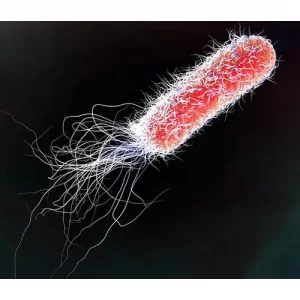
E.coli Testing – Food and Beverage Safety. Image source: https://biolabtests.com/top-facts-ecoli/
How to Detect E. coli in Food and Water?
What is E. coli?
E. coli, or Escherichia coli, is a type of bacteria that is commonly found in the intestines of humans and some animals. Most strains of E. coli are harmless and can even be beneficial to the digestive system, but some strains can cause illness if consumed through contaminated food or water. E. coli is responsible for 75-95% of urinary tract infections and can also cause pneumonia. Some strains produce a toxin called Shiga, which can harm the lining of the intestine and cause abdominal cramps, vomiting, and bloody diarrhea. The O157:H7 strain is particularly dangerous and can lead to kidney failure, fever, and seizures. Healthy individuals usually recover within a week, but older adults and children are at a higher risk of complications.
To ensure the safety of consumers, E. coli detection in food and beverage products before distribution is crucial. Hence, in this blog, we will discuss various E. coli testing methods based on ISO7251:2005, ISO16649-1:2001, and ISO16654:2001 standards.
ISO 7251:2005 - Horizontal method for the detection and enumeration of presumptive Escherichia coli
ISO 7251:2005 is used to detect and quantify potential Escherichia coli by utilizing the liquid-medium culture method and calculating the most probable number (MPN) after incubation at 37°C and 44°C. This standard is suitable for detecting E.coli in food and water samples intended for human consumption, animal feeding, and environmental samples related to food handling and production.
Enrichment
Incubation
Incubate for 24hr ± 2hr at 37ºC.
Incubate negative tubes for up to 48hr ± 2hr.
Selective Enrichment of Positive Cultures
Incubation
Incubate for 24hr ± 2hr at 44ºC.
Incubate negative tubes for up to 48hr ± 2hr.
Confirmation of Positive Cultures
Incubation
Test for Indole Production
Results
ISO 16649 - Horizontal Methods for the Enumeration of β-glucuronidase-positive Escherichia coli
ISO 16649 is divided into three parts, which we will describe in detail.
ISO 16649-1:2018 - Colony-count Technique at 44 °C Using Membranes and 5-bromo-4-chloro-3-indolyl beta-D-glucuronide
In order to prepare the test sample, it is important to follow the relevant International Standard that pertains to the specific product in question, as outlined in ISO 6887 (all parts). In cases where there is no specific International Standard available, it is advisable for the parties involved to come to an agreement on the appropriate method for preparing the test sample.
Ressucination
Incubation
Incubate for 4hr ± 1hr at 37ºC.
Isolation
Incubation
Incubate for 18-24hr at 44ºC (Not more than 4 plates high)
Results
ISO 16649-2:2001 - Colony-count Technique at 44 °C Using 5-bromo-4-chloro-3-indolyl-D-glucuronide
To prepare the test sample, it is necessary to follow the specific International Standard that is relevant to the particular product. In case there is no specific International Standard available, it is recommended that the involved parties should mutually agree on the appropriate preparation method.
Isolation
Incubation
Incubate for 18-24hr at 44ºC OR
Incubate for 4hr at 37ºC followed by 18-24hr at 44ºC (if stressed cells is suspected)
Results
ISO 16649-3:2015 - Detection and most probable number technique using 5-bromo-4-chloro-3-indolyl-ß-D-glucuronide
Selectively Enrichment
Incubation
Incubate for 24hr ± 2hr at 37ºC
Confirmation
Calculate MPN
ISO 16654:2001 - Horizontal method for the detection of Escherichia coli O157
Selective Enrichment
Incubation
Incubate for 6 hr at 41.5°C and for a further 12−18 hr
Immunocapture
Selective Isolation
Inoculate onto Sorbitol MacConkey Agar (CM0813) + Cefixime-Tellurite Supplement (SR0172) and one other medium of choice e.g. Cefixime Rhamnose Sorbitol MacConkey Agar (CM1005) + Cefixime Supplement (SR0191) or Brilliance E. coli / Coliform Agar (CM0956B)
Incubation
Purity Plate
Incubation
Confirmation E. coli O157 is confirmed by indole production and agglutination with E. coli O157 antiserum
*To obtain more comprehensive information about the ISO standards mentioned earlier, kindly download the document titled ‘Making Food Safer According to ISO Methods’.
Alternative Methods for E.coli Detection
Thermo Scientific™ RapID™ ONE System
The RapID™ ONE System is a quantitative method which can rapidly identify more than 70 Enterobacteriaceae, including Salmonella species. Here are some of the features of the RapID™ System:
- One-Step Inoculation – decreased preparation time and increased productivity
- Manual microbial identification made easy – No Oil, No Pipetting, No 24 Hr Incubation
- Four (4) hour incubation – quicker time-to-result for a faster response
- Visible reaction – Reduce subjectivity and decrease testing
Thermo Scientific™ RapID™ SS/u System
With Thermo Scientific™ RapID™ SS/u System, you can quickly identify commonly found urinary tract pathogens, including E. coli, in just two hours. This identification system is based on enzyme technology.
- One-step inoculation—decreased prep time for increased productivity
Manual microbial identification made easy—no oil, no pipetting, no 24-hr incubation - Two-hour incubation—quicker time-to-result for a faster response
- Common procedure—lessened materials usage saves time and money
- Visible colour reactions—reduced subjectivity decreases repeat testing
- Better reporting—more coverage, advanced updates
SureTect PCR Assays
Thermo Scientific™ SureTect™ Food Safety PCR System is a solution that aims to simplify food pathogen testing, including E. coli by providing straightforward workflows and fast, accurate results. This system is capable of detecting foodborne pathogens and other critical food safety and quality indicators with ease.
The simplified workflows and quick reporting of this system enable quicker product release and interventions, which can significantly benefit your operations. The PCR assays offered by this system can detect major pathogens and other significant targets in a variety of samples, such as food, animal feed, primary production, and environmental manufacturing.
Wrapping Up: Key Takeaways for E.coli Detection
In conclusion, the detection of E. coli in food and beverage products is a critical step in ensuring the safety of consumers. By following the ISO standards discussed in this blog, laboratories can perform accurate and reliable testing for E. coli. Additionally, the Thermo Scientific™ SureTect™ Food Safety PCR System offers a visibly simple solution for detecting E. coli and other foodborne pathogens with streamlined workflows and rapid reporting. Don’t hesitate to contact us to learn more about our solutions for E. coli testing and other food safety challenges.
Reference:
1. WebMD. (n.d.). E. coli bacteria infection: Symptoms, treatment, causes & prevention. WebMD. Retrieved February 23, 2023, from https://www.webmd.com/food-recipes/food- poisoning/what-is-e-coli
2. Mayo Foundation for Medical Education and Research. (2022, October 1). E. Coli. Mayo Clinic. Retrieved February 23, 2023, from https://www.mayoclinic.org/diseases- conditions/e-coli/symptoms-causes/syc-20372058
3. Dura, S. (2022, March 22). E. coli virotypes food poisoning, infection and illness. Microbe Notes. Retrieved February 23, 2023, from https://microbenotes.com/e-coli-food-poisoning/
4. ISO 7251:2005. ISO. (2019, December 16). Retrieved February 23, 2023, from https://www.iso.org/standard/34568.html
5. Most probable number technique in Escherichia coli count using ISO. (n.d.). Retrieved February 23, 2023, from https://www.researchgate.net/publication/328253453_Most_probable_number_technique _in_Escherichia_coli_count_using_ISO_16649- 3_ISO_7251_and_rapid_test_enumeration_device_TEMPO_EC_methods_in_milk_and_dairy _products
6. Health Life Media Team (2015, December 13). Health Life Media. Retrieved February 23, 2023, from https://healthlifemedia.com/healthy/food-poisoning-what-are-e- coli-breakouts/
7. Food Safety – Oxoid. (n.d.). Retrieved February 23, 2023, from
http://www.oxoid.com/pdf/iso-food-safety-brochure.pdf
8. RapID™ One system. Thermo Fisher Scientific – US. (n.d.). Retrieved March 5, 2023, from https://www.thermofisher.com/order/catalog/product/R8311006
9. SureTect™ PCR Food Pathogen Testing: Thermo Fisher Scientific™ – US. Food Pathogen Testing | Thermo Fisher Scientific – US. (n.d.). Retrieved March 5, 2023, from https://www.thermofisher.com/my/en/home/industrial/food-beverage/food-microbiology- testing/food-microbiology-detection-quantification/pcr-food-testing-pathogen- detection/suretect-pcr-food-pathogen-testing.html#validation


